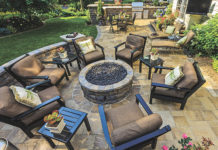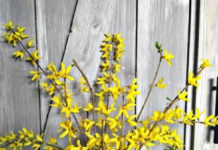Cool Weather Doesn’t Mean The End Of Fresh Veggies
By Gretchen C. Van Benthuyen
Summer is over. Days are shorter. Nights are cooler. Time to put your garden to bed and relax, right? Nope.
Year-round gardening has increased in popularity for many reasons. Bottom line? Consumers want delicious vegetables and herbs from either indoor or outdoor gardens that taste much better than anything store-bought 365 days a year.
By extending your outdoor harvest in the fall (maybe to Thanksgiving if the weather is mild) and beginning it earlier in the spring (weeks before Mother’s Day), you can save money, eat fresh, and reduce dependence on vegetables grown thousands of miles away. And that’s a good thing.
First, we’ll talk about the outdoors, then indoor gardening tips.
To extend the outdoor season in New Jersey, you have to go undercover. If your plants battle strong winds, they’ll use energy to survive rather than growing strong root systems.
So familiarize yourself with raised beds, frost cloths, row covers, polytunnels, cold frames and heated greenhouses. Your needs will dictate which of these you require.
Garden fabric retains heat and keeps soil several degrees warmer, giving heat-loving crops, such as peppers, okra and tomatoes, a couple extra weeks to ripen. (Once you see some red on green tomatoes, you can bring them inside to finish.)
As for cold weather crops, you still have time to plant seedlings (small plants), but it’s too late for planting seeds.
Most local garden centers offer 4- and 6-packs of seedlings in spring, but not in the fall when the focus is on mums, pumpkins and ornamental flowering kale – which tastes awful. There just isn’t a market for them now.
But you can order online from several sources. Burpee, for instance, is offering seedlings of winter kale, spinach, brassicas (broccoli, cauliflower, brussels sprout) as well as potatoes. Garlic, rhubarb and asparagus also are available now for harvesting next spring.
Other cold weather crops (start these from seeds next year six to eight weeks before planting outdoor) include spinach, parsley, collards, rutabagas, turnips, carrots, beets, radishes, Swiss chard, leeks and mesclun mix (salad greens including leaf lettuces, mache, arugula, mustard).
Renee Mongiovi owns Oasis Backyard Farms in Colts Neck. She designs and installs fruit and vegetable gardens for clients and this year created almost 50.
Earlier this month she was planting leafy greens, lettuces, kale and chard plants for clients. She also planted spinach which, she said, will produce a little this fall “but comes up like gangbusters in the spring.” In mid-October she plants garlic and shallots, which won’t be harvested until June or July 2017.
For the first time, her 7-year-old business now is offering row covers for vegetables due to customer demand.
“Last year we harvested through December since it was so mild,” she said. “But you can’t count on that. We usually get a frost the end of October.”
Traditionally, the frost date in Monmouth County is the first week of November.
“Kale can tolerate a frost and actually tastes sweeter,” she said. “The plant reacts to the cold by creating more sugar.”
But freezing weather and wind are deadly for naked vegetables.
“Hoop houses and row covers can make a big difference at the end of the season and helps get things like lettuce started earlier in the spring,” she explained. “I use hoops and Agribon row covers which will protect plants when the temperature drops down into the high 20s. It also protects against the wind chill.”
The row covers will support the weight of the snow as well as keep out bugs in the spring.
Also, look for microclimates around your house, particularly on the south side where the sun is strongest and your foundation may keep the soil a few degrees warmer. It’s an excellent location for a cold frame. Fill it with good garden loam. Avoid low spots where cold air and frost readily settle.
Check online for the following: venting cold frames starting at about $40, a garden tunnel cover and wire kit (50 feet) for $43, and a floating row cover, 72×50 inches, for $20. Some local garden centers may still have similar items.
If you prefer indoor gardening and really crave homegrown greens year-round — soil, or no soil, that is the question.
You can still set up the ol’ fluorescent ceiling light hanging over cells planted with seeds sitting on a heating mat so they germinate. You can even buy table lamps with grow lights to do the same in small spaces.
A newer home gardening trend based on an ancient practice is soil-less, self-contained gardens that thrive in water – tabletop and towers – and usually include the word aero in the product name and/or description.
They come with seedpods you insert into holes and you’re done planting. Just wait for your harvest. You can get one at Target for $70 or one for $300 at Williams-Sonoma.
Mongiovi uses the Tower Garden, a vertical aeroponic system that uses 20 rockwool cubes, vermiculite and net pots to grow non-GMO basil, beefsteak tomato, bell pepper, cherry tomato, cucumber, eggplant and gourmet lettuce seeds.
She, however, only grows greens because she doesn’t want to bother having to hand-pollinate the flowers in order to get fruit. She keeps it in her home office and uses it year round.
“Lettuce doesn’t like the deep heat of summer and I love fresh greens in the winter,” she said. Plants also mature more quickly, she added.
She’s been offering them to clients with limited space as they measure 62x30x30 inches. She puts them together, sets up the pumping system and plants the vegetables. When used outside they do not need additional lighting. Once inside, she said, you need about 15 hours of light per day. They sell for $543, with accessories such as lights and a dolly for rolling the tower around costing extra.
MORE SOURCES:
BURPEE: http://www.burpee.com for seedlings and seeds. 1-800-888-1447
TOWER GARDEN http://www.towergarden.com
OASIS BACKYARD FARMS http://www.oasisbackyardfarms.com; 732-294-8703
BOOK “The Year-Round Vegetable Gardener: How to Grow Your Own Food 365 Days a Year, No Matter Where You Live” by Niki Jabbour, who gardens in Nova Scotia, Canada
GARDENER’S SUPPLY http://www.gardeners.com/how-to/how-to-grow-salad-greens-all-year/7272.html?SC=XNET9465
PLANET NATURAL https://www.planetnatural.com/growing-indoors/ includes advice on which grow lights are best
PINTEREST For winter vegetable ideas and advice https://www.pinterest.com/explore/winter-vegetable-gardening/You














